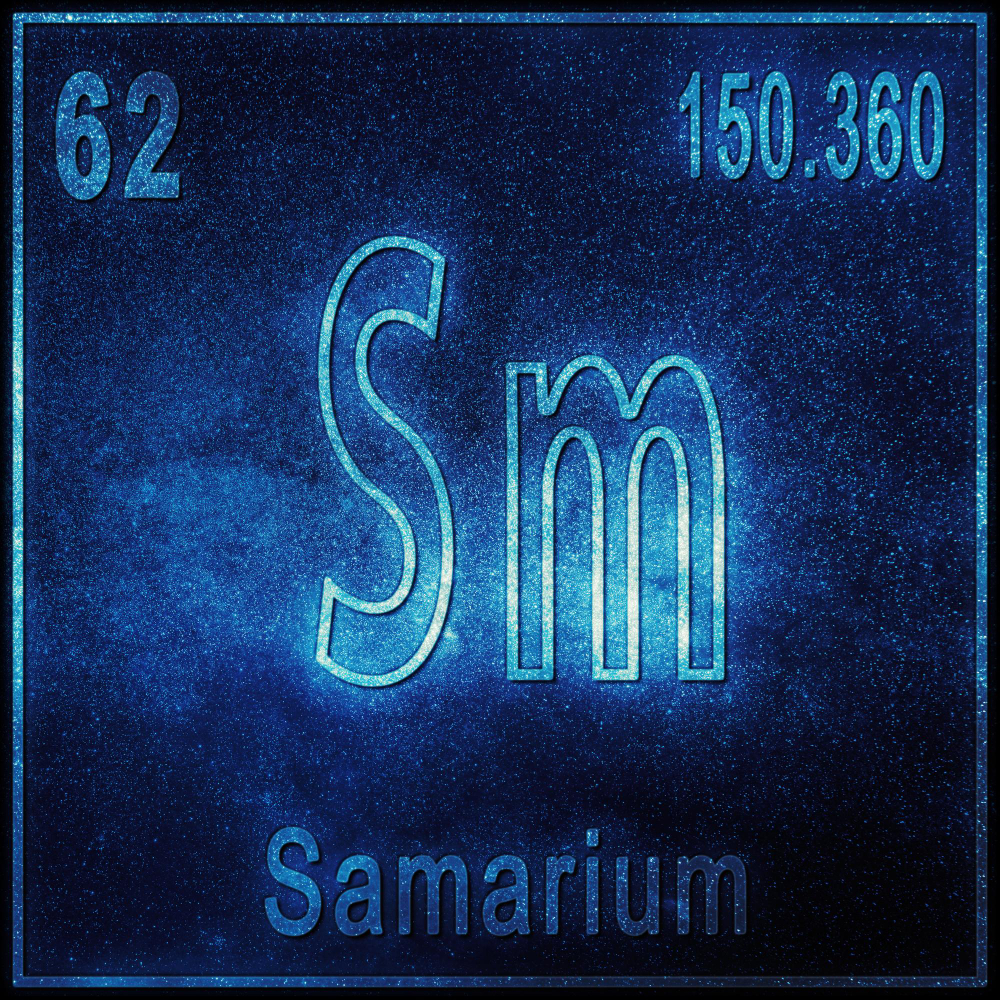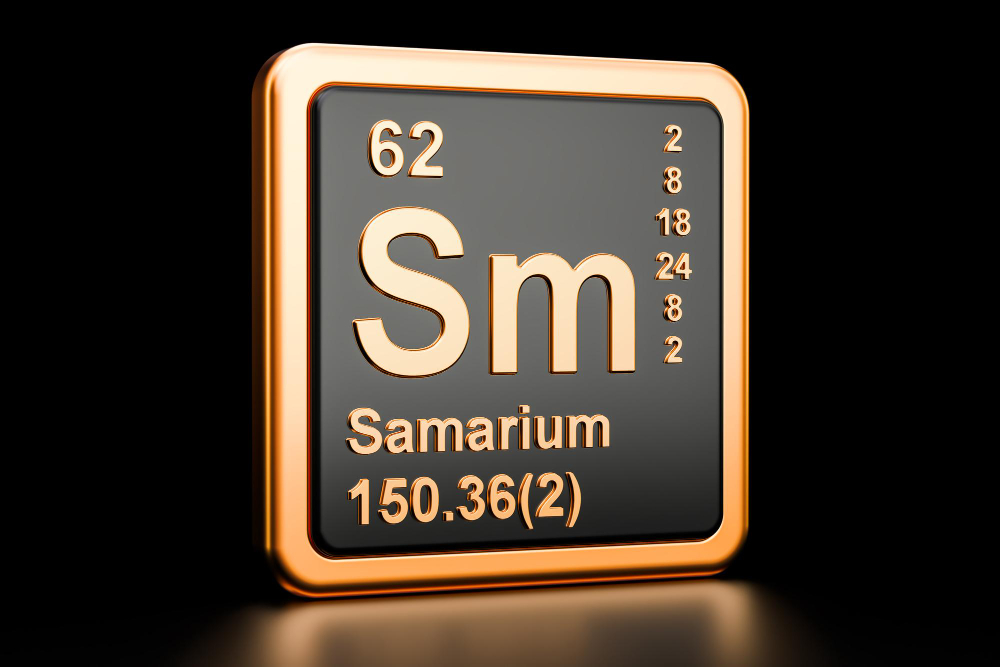Samarium (symbol: Sm, atomic number: 62) is a rare earth element that belongs to the lanthanide series of the periodic table. It is a soft, silvery metal that is relatively stable in air compared to other lanthanides but can tarnish when exposed for long periods. Like other rare earth metals, samarium plays a vital role in various high-tech applications, owing to its unique physical and chemical properties.
Discovered in the late 19th century, samarium was named after the mineral samarskite, from which it was first isolated. This mineral itself was named after the Russian mining engineer Vasili Samarsky-Bykhovets, making samarium one of the few elements named after a person. The element was first identified in 1879 by French chemist Paul Émile Lecoq de Boisbaudran.
In modern times, samarium has become important in both scientific research and industrial use. It is widely recognized for its role in the production of powerful permanent magnets, known as samarium-cobalt (SmCo) magnets, which are critical in various high-performance applications such as motors, headphones, and precision equipment. Additionally, samarium isotopes are used in nuclear reactors as a neutron absorber, and the element has applications in specialized glass, phosphors, and catalysis in organic synthesis.

Properties of Samarium
Physical Properties
Samarium, with an atomic number of 62 and an atomic mass of 150.36 g/mol, is a soft, malleable metal that belongs to the lanthanide series. Like other rare earth elements, it is fairly reactive, especially when exposed to air and water. Its metallic appearance is silvery, but it can quickly tarnish upon contact with oxygen. In nature, samarium is primarily found in minerals such as monazite and bastnäsite, which are important sources of many rare earth elements. These minerals are mined and processed to extract samarium for various applications, particularly in high-tech industries.
Chemical Properties
Chemically, samarium is quite reactive. It oxidizes quickly in air, leading to the formation of a thin layer of tarnish that dulls its shiny surface. This oxidation is a common characteristic among lanthanides. When exposed to acids, samarium reacts vigorously, dissolving and forming salts. Additionally, samarium is a strong reducing agent in chemical reactions, capable of donating electrons to facilitate the reduction of other compounds. In most of its chemical compounds, samarium commonly exists in a +3 oxidation state, where it forms stable complexes and oxides. This oxidation state plays a key role in its chemical reactivity and applications.
Isotopes
Samarium has several naturally occurring isotopes, each with its own importance in various fields. One of the most significant isotopes is Samarium-149, which is utilized in nuclear reactors as a neutron absorber, helping to control the fission process. Another key isotope is Samarium-153, which has found valuable uses in medicine. Samarium-153 is employed in radiopharmaceuticals for the treatment of bone pain associated with cancer, due to its ability to deliver targeted radiation to affected areas. These isotopes highlight the diverse utility of samarium, ranging from energy production to medical treatments.
Sources and Extraction of Samarium
Natural Sources
Samarium is primarily sourced from minerals rich in rare earth elements, with monazite and bastnäsite being the most common ores. These minerals contain a mixture of rare earth elements, including samarium, and are typically found in geological deposits alongside other lanthanides. Samarium is not found in its pure elemental form in nature, but rather as part of these mixed ores, making its extraction dependent on the separation from other closely related elements.
Global Mining and Production
The primary countries involved in the mining and production of samarium and other rare earth elements include China, the United States, and India. China is by far the leading producer of rare earth elements, including samarium, due to its large reserves and well-developed infrastructure for processing rare earth minerals. The United States and India also have significant deposits and contribute to global production, though on a smaller scale. As demand for rare earth elements has grown, these regions have increased their focus on efficient mining and extraction methods to support various industries.
Extraction Process
The extraction of samarium from its ores is a complex process that involves separating it from other lanthanides present in the same mineral deposits. This is typically achieved using advanced separation techniques such as solvent extraction or ion exchange. These processes exploit the subtle differences in chemical behavior between the lanthanides. In solvent extraction, an organic solvent is used to selectively extract samarium from a mixture of rare earth elements. Ion exchange, on the other hand, relies on exchanging ions between a solution and a resin to isolate specific elements. Once separated, the samarium can be further refined to obtain the pure metal or its compounds, ready for industrial or scientific applications
Key Applications of Samarium
Samarium plays a critical role in several high-tech and industrial applications due to its unique chemical and physical properties. One of its most prominent uses is in the production of Samarium-Cobalt (SmCo) magnets. These high-performance magnets are known for their exceptional resistance to demagnetization and their ability to retain magnetic strength even at high temperatures. This makes them indispensable in applications where strong, stable magnets are required, such as in electric motors, high-fidelity headphones, and components used in the aerospace industry.
In the nuclear sector, Samarium-149 is used as a neutron absorber in control rods for nuclear reactors. Its ability to capture neutrons helps regulate the fission process, maintaining the safety and efficiency of the reactor. This application is crucial for controlling nuclear reactions and ensuring long-term stability in power generation systems.
Samarium also has important medical applications, particularly in the form of the isotope Samarium-153. This isotope is used in radiotherapy to treat certain types of cancer, particularly bone cancer and bone metastases. Samarium-153 delivers targeted radiation therapy, providing pain relief and slowing cancer progression in affected bones.
Samarium is used to dope lasers and infrared-absorbing glasses, as well as in the production of phosphors for lighting. These materials improve the performance of devices that require high optical sensitivity and energy efficiency. Additionally, samarium serves as a catalyst in certain chemical reactions, contributes to the manufacture of ceramic capacitors, and is used in glass polishing processes, further demonstrating its versatility in various industrial applications.
Environmental and Economic Impact of Samarium
The extraction and processing of samarium, like other rare earth elements, pose significant environmental challenges. Rare earth mining often results in considerable waste production, which can contain toxic chemicals and radioactive materials, especially when mining monazite ores that may be associated with thorium. Proper waste management is a major concern, as improper disposal can lead to soil and water contamination, posing risks to ecosystems and human health. In response, there have been increasing efforts to make rare earth mining, including samarium extraction, more sustainable. Techniques are being developed to improve resource efficiency, reduce environmental damage, and minimize the hazardous by-products of mining.
On the economic front, the demand for samarium has been growing due to its critical role in emerging technologies. It is a key component in renewable energy systems, such as wind turbines, and electric vehicles, where high-performance magnets are essential. Additionally, samarium is widely used in the aerospace sector, where its ability to maintain magnetic properties under extreme conditions is highly valued. As global industries transition toward greener technologies, the demand for rare earth elements like samarium is expected to increase further.
However, the global supply chain for rare earth elements faces significant challenges. The concentration of rare earth mining in a few countries, particularly China, creates a supply bottleneck that can be vulnerable to geopolitical tensions and trade restrictions. Resource scarcity and the difficulty of extracting and processing rare earth elements further complicate the supply chain. As a result, many countries and industries are investing in the development of recycling technologies and alternative sources to reduce dependence on primary rare earth mining, helping to ensure a stable and sustainable supply of materials like samarium in the future
Future Outlook for Samarium
As the world continues to advance in technology and embrace cleaner energy solutions, the demand for samarium is expected to rise significantly. With its essential role in high-performance magnets, samarium will remain crucial in sectors like renewable energy, where these magnets are key components in wind turbines and electric vehicle motors. The aerospace industry will also continue to rely on samarium for its stability and performance under extreme conditions. These trends signal a strong future demand for samarium, especially as global efforts intensify to transition toward sustainable energy and innovative technologies.
However, addressing the environmental challenges associated with samarium extraction and the broader rare earth industry will be critical to ensuring its future. As environmental regulations become stricter, there will be a growing push for the development of more sustainable mining practices. Innovations in recycling and recovery technologies for rare earth elements, including samarium, are also expected to play a major role in reducing the environmental footprint of these materials and decreasing reliance on new mining.
Geopolitically, securing a stable supply chain for samarium will remain a priority. With much of the world’s rare earth production concentrated in a few regions, countries will continue to explore alternative sources and strategies to diversify their supply chains. Research into efficient recycling methods and efforts to find substitutes for rare earths in some applications will also help mitigate potential supply disruptions. The future of samarium thus lies at the intersection of technological advancement, environmental stewardship, and global resource management, as industries strive to meet rising demand while addressing the challenges that come with it

